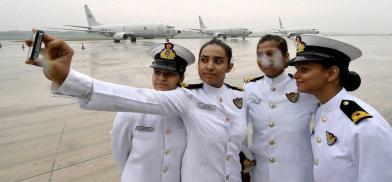The final frontier: Women in combat roles must become the new normal
In the Indian context, the Indian Air Force and the Indian Navy have granted a permanent commission to women officers even as both have opened up some combat roles for women, write Subhranil Ghosh & Sayantan Bandyopadhyay for South Asia Monitor

The Supreme Court judgment of February 17, 2020 has made it possible for women army officers in India to be eligible for permanent commissions, allowing them to be in command roles. The judgment was passed on a plea filed by women officers and was being heard by a Supreme Court bench comprising Justices D.Y. Chandrachud and Ajay Rastogi. The petition concerned the denial of Permanent Commission (PC) to women officers in response to the central government filing appeals against a 2010 judgment of the Delhi High Court.
The judgment held that Short Service Commissioned (SSC) women officers of the Air Force and the Army, who had applied for Permanent Commission (PC) but were only given extension commensurate to the SSC level, are entitled to PC on par with male Short Service Commissioned officers with all consequential benefits. The arguments put forward by the government for barring entry of women were manifold but it is important to first understand what notions are held by antimilitaristic feminist scholarship.
Scholars like Catherine MacKinnon and Cynthia Enloe have pointed out to the connection between masculinity and violence as well as the relation between non-violence and nurturing. They highlight how a man’s virility is determined by the degree of violence he can inflict upon his opponent; how male sexuality and force are interlinked and how combat is fundamental to male superiority. To that end, feminists argue that women should not fight in men’s wars and women empowerment would only be complete when women made wars obsolete.
While these assertions are unmistakably noble, they fail to take into consideration two crucial points: one, wars are inevitable given the inherently unstable nature of the International system and two, there is a widely circulated “protection myth” that espouses protection of vulnerable sections of society by the armed forces. War has exposed the fallacy of this myth, showing that women can no longer rely upon male combatants to safeguard their interests. Under these circumstances, women in combat roles have to become the new normal. In the Indian context, the Indian Air Force and the Indian Navy have granted a permanent commission to women officers even as both have opened up some combat roles for women.
The Air Force allows women as officers in flying and ground duties with SSC officers flying helicopter, transport aircraft and now even fighter jets. In the Navy, women officers inducted through SSC are allowed in logistics, law, observers, air traffic control, maritime reconnaissance pilots and Naval Armament Inspectorate Cadre. It is necessary to understand the nuances of the rationale provided by the government against the court ruling. The notion of different physical standards of men and women has its roots in the archaic belief that women are physically inferior to men. This belief system links physical prowess to biology and not to privilege and access.
The counter-narrative has been slow to build up but has offered powerful arguments. For example, extensive physical tests conducted by the Dutch and the Canadian Armed Forces in the 1970s and 1980s respectively found that women with the requisite training and necessary adaptations can compete with men in the physical standards. More importantly, the criterion of physical standards should be engineered to ascertain combat effectiveness if anything, and not stereotypical ideas about fitness.
The Supreme Court in its verdict has lamented the central government’s submissions highlighting the “physiological limitations” of women officers. In a section titled “stereotypes and women in the armed forces”, the bench said that submissions such as those citing pregnancy and motherhood as reasons for not granting permanent commission to women were based on “sex stereotypes”.
The top court’s efforts to nullify these sex stereotypes and facilitate social progress have been lauded by none other than President Ram Nath Kovind himself, stating that the Supreme Court is committed to the pursuit of gender justice. The judges also reprimanded the act of casting baseless aspersions on the abilities of women on the basis of gender, stating that it amounted to a serious affront not only to the dignity of women but also to the dignity of the members of the Indian Army.
Furthermore, the Supreme Court referred to Article 14 of the Indian Constitution while admonishing the policy of absolute exclusion of women from command appointments. On February 25 last year, the Centre had adopted a policy decision to grant PC to SSC women officers in eight streams of Indian Army - Signals, Engineers, Army Aviation, Army Air Defence, Electronics and Mechanical Engineers (EME), Army Service Corps, Army Ordnance Corps, and Intelligence), in addition to the existing two streams of Judge Advocate General and Army Educational Core (AEC).
The policy, however, did not apply, to SSC women officers with service above 20 years. The policy thus was challenged for denying equal benefits to all classes of SSC women officers. The top court pointed out the “fundamental fallacy” in denying PC to women based on years of service which is tantamount to a “travesty of justice.”
The court also charged the government for causing “irreparable prejudice” by failing to implement the Delhi High Court Judgment of 2010 in the last ten years.
For an organization that prides itself on maintaining a high degree of professionalism and integrity, the increased visibility of women should not come as a source of discomfort and unease. Rather it should be encouraged, and since there is ample evidence to show that the required skills set are largely gender-neutral, this judgment will have larger ramifications on gender relations throughout the sub-continent.
By far, the most obtuse submission by the government in court has been that since most of the cadre hails from rural backgrounds, the soldiers are simply not culturally hardwired to view women as commanding officers, let alone obey their command. But this idea can be easily challenged as there are survey reports that show a majority of male jawans (soldiers) who have worked with women officers see them as good leaders. The problem of a retrograde mindset can only be solved if the army sets down some professional code of ethics. By embracing this change the armed forces can act as a torchbearer for larger society. It must be emphasized that while a soldier may come from the hinterlands, while in service he or she is expected to perform his or her duties thoroughly. They are in service of the nation, and national security inevitably takes precedence over gender relations' power equations. In this respect, the recent judgment is welcome and overdue.
(The writers are postgraduate students of Political Science with specialisation in International Relations at Department of International Relations, Jadavpur University. Kolkata)














Post a Comment